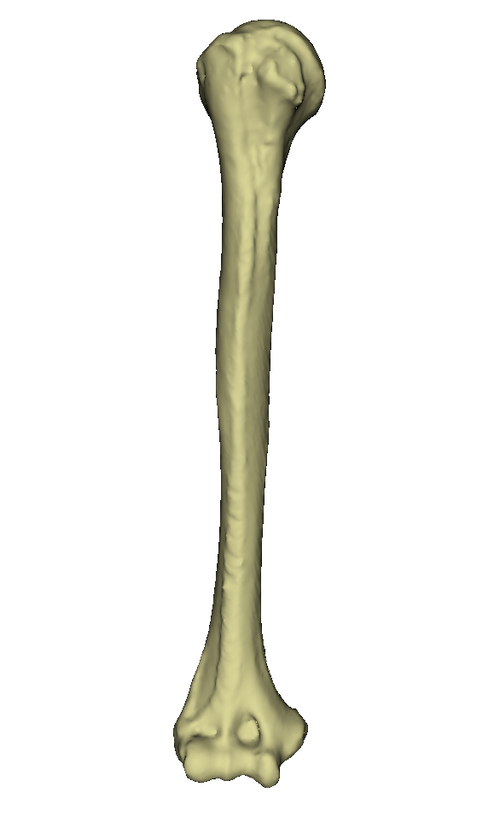Humerus
Structure of the humerus
The humerus is articulately connected to Scapula, Ulna and Radius.
It consists of the corpus and a proximal and distal extremitas. The proximal end forms the caput humeri (1) with the adjacent neck, collum humeri. It appears slightly retracted and is also called collum anatomicum. The distal end is formed by the condylus humeri (3).
On the anterior surface of the extremitas proximalis is laterally the tuberculum majus (4) and medially the tuberculum minus (5). Between the two there is a strong depression, the Sulcus intertubercularis (6), which serves as a slide rail for the tendon of the Caput longum of the M. biceps brachii.
The Sulcus n. radialis (7) is located at the posterior surface of the corpus humeri. At the distal Extremitas there is medially the stronger bone projection, Epicondylus medialis (8), and laterally the weaker Epicondylus lateralis (9).
Trochlea humeri (10) and Capitulum humeri (11) form the Condylus humeri and serve as an articulated connection with the forearm bones. Medially from the Trochlea humeri runs a shallow channel, the Sulcus n. ulnaris (12). The Fossa olecrani (13), a deep pit, is located above the Trochlea at the posterior surface of the humerus.
The humerus is torqued at its proximal end, i.e. the caput is twisted about 20° backwards from the axis by the epicondyli humeri (torsion). Between the longitudinal axis of the humerus and the caput there is an average angle of 130°, while at the distal end, between the transverse joint axis and the longitudinal axis of the humerus shaft, there is an angle of 76° to 89°.
The bony socket (Cavitas glenoidalis) of the Articulatio humeri, a ball joint, is considerably smaller than the head of the humerus. The socket is enlarged by a fibrous cartilaginous joint lip, Labrum glenoidale. The surface of the Cavitas glenoidalis is approx. 6 sqcm. The weight of the upper extremity is about 4 kg. Since there are no stronger ligaments, the muscles surrounding the joint must secure it. This is known as a muscle-secured joint. The so-called "rotator cuff" is part of this muscular securing and especially strengthens the joint capsule.
The Caput humeri (1) is approximately spherical. The synovial joint capsule is attached to the Labrum glenoidale of the scapula. It extends like a bag along the intracapsular tendon of the long biceps head and embraces it with a vagina synovialis intertubercularis, which is located in the sulcus intertubercularis (5).
Bewegungen in drei Freiheitsgraden sind möglich. Man spricht von Abduktion und Adduktion, wobei man von der Ruhestellung des Caput humeri in der Scapula-Ebene ausgeht. Man kennt die Anteversion, das nach vorne Heben des Armes und ihre Gegenbewegung, die Retroversion. Durch eine rotatorische Komponente ergibt sich unter Mitwirkung der vorher genannten Bewegungen eine zusammengesetzte Bewegung, die Zirkumduktion oder das Kreisen, wobei der Arm praktisch einen Kegelmantel beschreibt.
Bei den Abduktionsbewegungen kommt es immer zu einer Mitbewegung der Scapula; eine exzessive Mitbewegung der Scapula tritt bei einer Abduktion über 90 Grad ein (Elevation).
weiterführende Links
